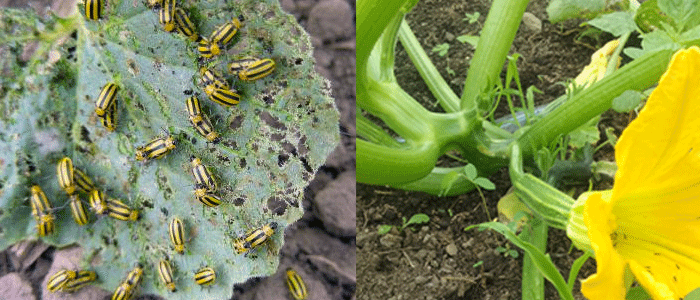Beating the beetle
By Nick Swetye
June 2, 2018
Two weeks ago, we wrote the 2018 zucchini crop off. Cucumber beetles had absolutely decimated the sprouting Romanesco heirloom zucchini plants in our new high tunnel.
We had direct-sowed the seed in April, which often leads to increased pest pressure – especially for members of the cucurbit family. With dozens of black and yellow striped beetles nibbling on every plant, several of the zukes never grew beyond the primary leaf stage, and bacterial wilt – commonly vectored by the striped cucumber beetle – seemed to already be settling in.
So how did we go from that to this…
in just two weeks?

First, we learned that if we could get the zucchini to the fifth leaf stage, the plant’s growth would outstrip the beetles’ hunger and our zuchinni would survive. So we pushed the fertility with a few foliar sprays of fish emulsion, which gives the plant exactly what it needs to grow new plant material fast.
Chemical-based fertilizers are only 10%-15% plant available, and require micro-organisms in the soil to prepare them for uptake by the plant’s roots. Fish emulsion, however, is in a bio-available, plant-ready form. Foliar sprays and a light soil drench, meant the plants would get their goodies straight away.
The best way to give your plants the help they need for their immune systems is much the same as it is in humans – give them their vitamins!
Next, we had to deal with the diseases that come from cucumber beetles, the worst of which is sudden wilt, but many others come with these little pests. The best way to give your plants the help they need for their immune systems is much the same as it is in humans – give them their vitamins!
Thinking outside the NPK box
The topic of trace minerals deserves many volumes, and the use of rock powders vs chemical fertilizers in agriculture is a centuries-old debate. The short version is this – it’s not just NPK (nitrogen, phosphorus, potassium) that plants need. There is a whole constellation of trace minerals that are required for plants to produce the metabolites they need for self-defense. Not coincidentally, these are the same compounds that we associate with the medicinal benefits of many plants.
Trace minerals include iron, chromium, copper, zinc, iodine, manganese, selenium, bromine, boron, nickel, lithium, strontium and others. Not the kinds of things typically included on a nutrition label, but vital for things like maintaining the integrity of cell walls, healthy tissue development and membrane architecture, and the building blocks of enzymes and hormones.
The only place we get trace minerals from is our diet, and the only way for plants to offer them is to have them ready and available in the soil.
If you dehydrate the human brain, what you end up with is fats and trace minerals, particularly concentrated in the frontal lobe where things like problem solving, spontaneity, memory, language, judgement, impulse control, and empathy are processed. In short, if we don’t have a diet rich in these obscure, often overlooked trace minerals, we are in a lot of trouble. The only place we get these minerals from is our diet, and the only way for plants to offer them is to have them ready and available in the soil.
Trace minerals to the root zone
As you can guess, most agricultural soils are woefully deficient. With each year’s harvest, more trace minerals are extracted. And these must be returned to the root zone of our crops by either rock powder applications or deep tillage followed by a period of cover cropping and rest to allow for microbes to break these minerals from their rocky bonds.
The world’s premier source of plant-ready, non-radioactive trace minerals and rare earth metals in our backyard!
It just so happens that we have one of the world’s richest sources of trace minerals practically in our back yard – the Spanish River Carbonatite mine located just north of Toronto, Canada. It is a unique magmatic formation some 425 meters (1,400 ft) in depth and is possibly the world’s premier source of plant-ready, non-radioactive trace minerals and rare earth metals. It’s a holy cow of agricultural amendments and we just happened to have a few hundred pounds to experiment with.
Taste it to believe it!
So we threw a few tablespoons into a one gallon sprayer, added some pond water, and gave the zukes a thorough drenching. Two weeks later, here are the results:

We couldn’t be more impressed. June 2nd, and we have our first zucchini ready for harvest from plants we thought were a total loss.
Look out for our Romanesco Heirloom Zucchini in your City Fresh shares this season!
We are so impressed here at the George Jones Farm that we’ve been giving ten pound samples to each of the farmers in the City Fresh network. If this product continues to perform, we plan to have our first 10-ton load delivered in mid summer and will begin distributing it throughout the region.
So look out for our Romanesco Heirloom Zucchini in your shares, and enjoy the brain candy compliments of the New Agrarians here at City Fresh and the George Jones Farm. [CF]
